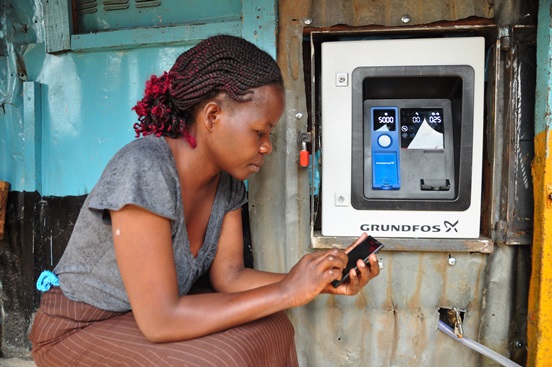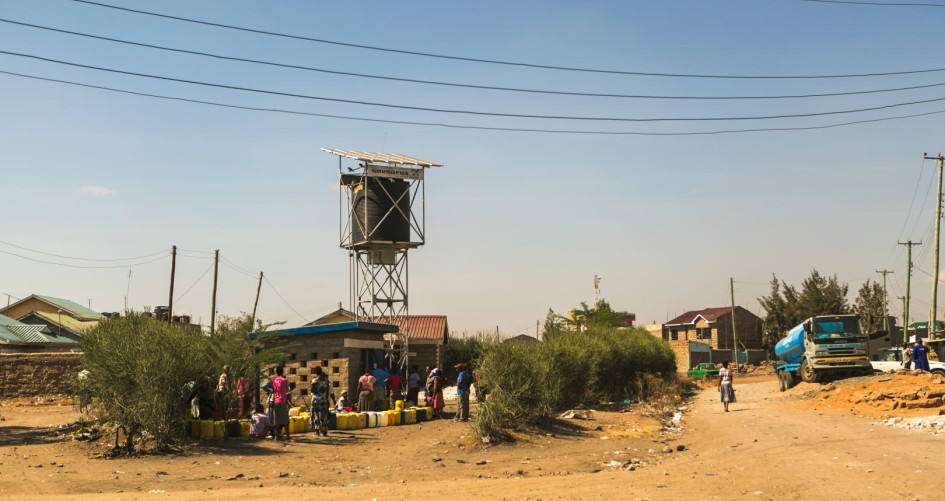Grundfos Lifelink Water Solutions helps build resilience to the effects of climate change by providing access to safe, sustainable and affordable water to people in developing countries. Lifelink systems can be installed in large or small water schemes in both urban and rural settings. In urban areas, Lifelink systems can be connected to the water network or a water storage tank. In off-grid rural areas, Lifelink systems take the form of communal water points and mini-grids, drawing water from the ground or water treatment systems through solar-powered pumps. To collect water, people charge a smart card with credit bought onsite or via their mobile phones, insert it into the dispenser and pay for the water they need.
Key facts:
- 44 pilot sites have been established in parts of Kenya and Uganda, reaching more than 100,000 people since 2009
- A new version of the core dispenser unit, AQtap, is being introduced to the market and now operated by Nairobi City Water in an informal settlement area
- Grundfos has signed an agreement with World Vision International to reach 2 million people over the next 5 years by providing 1,000 Lifelink systems in 9 African countries
- These 1,000 Lifelink units are expected to build resilience to climate change and reduce CO2 emissions by 39,000 tonnes over their 15-year lifespan

The problem
For most countries in Sub-Saharan Africa, access to safe and reliable water remains a major challenge. In Kenya alone, 16 million people do not have access to clean water. Increased incidences of drought linked to climate change is worsening water scarcity, particularly in areas that have limited and sporadic rainfall, leading to migration and increased urbanization.
Public water utilities in developing countries also face challenges in living up to their obligation to provide people with a reliable access to a clean and affordable water supply. Crucial challenges include scaling up the distribution to serve an increasing number of people migrating into cities and living in informal settlements. This requires access to financing and the need to reduce non-revenue-water, which can account for losses of as much as 50% in some countries, due to leakage and theft

The solution
Grundfos, the world’s largest pump manufacturer, created Lifelink as a self-contained, self-financing, energy- and cost-efficient water delivery solution for communities in developing countries.
The heart of each Lifelink solution, the AQtap, is a single product that combines three elements essential to smarter water management: smart cards to store water credits; a dispenser unit to tap water and manage credits; and a water management system where data from transactions and operations are processed and published.
To collect water, people charge a smart card with credit bought onsite or via their mobile phones, insert it into the dispenser and pay for the water they need.
The cloud-based water management system receives and publishes all transactional and operational data from each water dispenser. The system also includes an alert function, which allows utilities to immediately detect – and respond to – operational problems so that maintenance can be carried out in a timely manner. This helps minimize operational downtime of the water kiosk.
With ICT tools to monitor and manage water points, water utilities are also incentivized and empowered to expand their water distribution to informal urban settlements, which crop up outside the infrastructure grid.

Helping the planet
The Lifelink system, with groundwater supply, uses submersible pumps with a permanent magnet motor for high energy efficiency operation. Each of the motors are fitted with built-in electronics to enable the use of renewable energy – eliminating the use of diesel power generation and reducing CO2 emissions.

Helping people
In addition to building resilience to climate change, the reliable supply of water from Lifelink systems can also provide communities with increased food security, as well as generate income. The water supplied by Lifelink units can be used to grow produce through greenhouse drip irrigation systems, as well as to water livestock. The community is able to sell the produce, as well as the water to others both in and outside the community. This allows the community to generate income, which it can invest in other adaptive measures towards climate change.
After the deployment of more than 40 units and reaching more than 100,000 people in the African region, Grundfos Lifelink has learned that people in developing countries are willing to pay for water if they have confidence that the system can be trusted. To earn this trust, the water service provider must price the water in collaboration with the local community, according to its capacity to pay. The revenue collected may be used to cover service and maintenance of the system, which helps eliminate extended downtime and disrepair from lack of resources, creating reliability. With an automated water kiosk, the users get the freedom to tap water when they choose and are not dependent on operating hours set by water vendors.

Spillover effect
Lifelink was designed with scaling-up in mind. It uses proven, low-cost, energy- efficient pump technology and offers after sales servicing and availability of spare parts, through a network of professional service partners to ensure a sustainable water supply. Lifelink’s remote monitoring function allows for centralized management of units in virtually any location and produces highly accurate, data to inform broader strategies and decision making.
Grundfos aims to scale up Lifelink solutions in 9 countries across Africa and Asia, and has signed an agreement with World Vision International to reach 2 million people over the next 5 years with 1,000 Lifelink water systems.




Images owned by the activity partners, all rights reserved.

